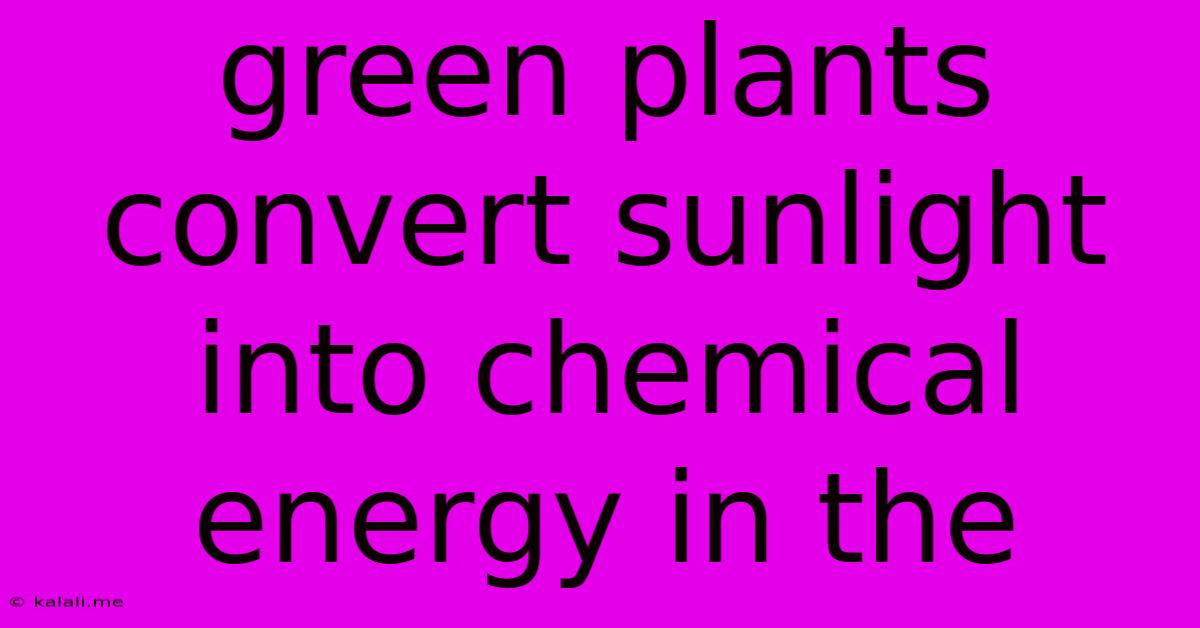Green Plants Convert Sunlight Into Chemical Energy In The
Kalali
Jun 14, 2025 · 3 min read

Table of Contents
Green Plants Convert Sunlight into Chemical Energy: Photosynthesis Explained
Meta Description: Discover the fascinating process of photosynthesis, where green plants harness sunlight to convert it into chemical energy in the form of glucose, fueling life on Earth. Learn about chlorophyll, light-dependent and independent reactions, and the importance of this vital process.
Photosynthesis is the cornerstone of life on Earth. It's the remarkable process by which green plants and other organisms, like algae and some bacteria, convert light energy into chemical energy. This chemical energy, stored in the form of glucose (a type of sugar), fuels the growth and survival of these organisms and, indirectly, supports nearly all other life forms on our planet. Understanding photosynthesis is key to understanding the delicate balance of our ecosystems.
Chlorophyll: The Key Player in Capturing Sunlight
The process begins with chlorophyll, the green pigment found in chloroplasts – specialized organelles within plant cells. Chlorophyll molecules are exceptionally efficient at absorbing light energy, particularly in the blue and red regions of the visible light spectrum. Green light, however, is largely reflected, which is why plants appear green to our eyes. This absorbed light energy is the driving force behind the entire photosynthetic process. Other pigments, like carotenoids (which contribute yellow and orange hues), also play a role in capturing light energy and protecting chlorophyll from damage.
Two Stages of Photosynthesis: A Detailed Look
Photosynthesis is broadly divided into two main stages: the light-dependent reactions and the light-independent reactions (also known as the Calvin cycle).
1. Light-Dependent Reactions: These reactions occur in the thylakoid membranes within the chloroplasts. Here, light energy is absorbed by chlorophyll and used to split water molecules (photolysis). This process releases electrons, protons (H+), and oxygen (O2), which is released into the atmosphere as a byproduct. The electrons are then passed along an electron transport chain, generating ATP (adenosine triphosphate) and NADPH – energy-carrying molecules that power the next stage.
2. Light-Independent Reactions (Calvin Cycle): This stage takes place in the stroma, the fluid-filled space surrounding the thylakoids. Here, the ATP and NADPH generated in the light-dependent reactions are used to convert carbon dioxide (CO2) from the atmosphere into glucose. This process, known as carbon fixation, involves a series of enzyme-catalyzed reactions. The glucose produced serves as the plant's primary source of energy and building blocks for other organic molecules like cellulose (for cell walls) and starch (for energy storage).
The Importance of Photosynthesis: Beyond Glucose Production
The significance of photosynthesis extends far beyond the simple production of glucose. It's the fundamental process that:
- Provides oxygen: The oxygen released during photolysis is crucial for the respiration of most living organisms, including humans.
- Forms the base of food chains: Plants, as primary producers, are the foundation of almost all food chains. Herbivores consume plants, and carnivores consume herbivores, demonstrating the flow of energy originating from photosynthesis.
- Regulates Earth's climate: Photosynthesis plays a vital role in regulating atmospheric CO2 levels, mitigating the effects of climate change.
- Supports biodiversity: The vast diversity of plant life on Earth is directly dependent on the efficiency of photosynthesis.
Factors Affecting Photosynthesis
Several environmental factors influence the rate of photosynthesis, including:
- Light intensity: Higher light intensity generally increases the rate, up to a saturation point.
- Carbon dioxide concentration: Increased CO2 levels can enhance the rate, especially at lower concentrations.
- Temperature: Photosynthesis operates optimally within a specific temperature range; extreme temperatures can inhibit the process.
- Water availability: Water is essential for photolysis; water stress significantly reduces photosynthetic rates.
In conclusion, photosynthesis is a complex yet elegantly efficient process that underpins life as we know it. Understanding its intricacies is essential for appreciating the delicate balance of our ecosystems and the importance of preserving plant life for future generations. Further research continues to unravel the complexities of this vital process, offering new insights into its potential for biofuel production and other applications.
Latest Posts
Latest Posts
-
Which Of The Following Is True Of Communication
Jun 15, 2025
-
What Is The Lcm Of 40 And 15
Jun 15, 2025
-
Which Statement About The Mercalli Scale Is True
Jun 15, 2025
-
Which Type Of Wave Has The Longest Wavelength
Jun 15, 2025
-
How Many Ias Officers Are Selected Every Year
Jun 15, 2025
Related Post
Thank you for visiting our website which covers about Green Plants Convert Sunlight Into Chemical Energy In The . We hope the information provided has been useful to you. Feel free to contact us if you have any questions or need further assistance. See you next time and don't miss to bookmark.